It’s not uncommon for dowel joints in older furniture to fail over time. In some cases, the dowel will snap off. In other cases, the hole may become oversized so the dowel will no longer fit snugly into it. Once a dowel hole starts to wear, it just gets worse over time because the loosened joint allows the dowel to slide around inside the hole, subjecting it to more and more side pressure that eventually elongates the hole. The net result is worn-out dowel hole syndrome. Repairing a worn-out dowel hole can be a tricky proposition because if the hole is not positioned properly, the joint will be misaligned or the mating pieces just won’t fit together at all.
While repairing a vintage walnut parlor table, I discovered a blown-out dowel hole where one of the legs connects to the underside of the apron. This particular leg had apparently been subjected to a lot of abuse in its day, enough to elongate the hole to almost twice its original size. Curiously, the neighboring dowel joint – there were 2 dowels per leg – did not appear to be worn at all. I would have expected both holes to show signs of wear but whatever…
Because the dowel hole was so badly worn, I couldn’t just glue in a dowel, cut if flush, and redrill the hole. That’s the standard fix that you’ll find in your mainstream DIY books and magazines. Instead, I had to fill in the irregular-shaped hole with a piece of wood, devise a way to find the original location of the hole, and then drill the hole.
The first step was to chisel out the hole a bit to a mostly uniform depth and width using a razor sharp 1/4″ wide wood chisel. I then cut a rectangular shaped piece of walnut that matched the overall dimensions of the hole and rounded one end using the stationary belt sander until the piece fit reasonably well into the hole. After that, I applied a two-part epoxy to the filler piece and matching hole and tapped in the filler piece. Once the epoxy cured, I cut the filler piece flush with the surrounding wood and gave it a quick sanding.
The nice thing about epoxy is that it fills in any voids in a patch such as this without shrinking, cures quickly (6-8 minutes), and can be drilled or sanded almost like wood. It also holds well, flexes with the wood, and doesn’t crack or fall out over time like certain wood fillers. Ok, epoxy commercial over. Onto the repair.
The next step was to redrill the dowel hole in the exact location as the original hole. This called for a little ingenuity because the outline of the original hole was no longer visible as a reference. However, the dowel holes for the other legs were still intact so I used a set of holes for one of these legs to create a drilling template.
The approach I came up with was to insert dowel centering points into each of the two dowel holes (I had to wrap a little tape around each centering point because they were a bit undersized). I laid a piece of plywood atop the centering points and gave it a light tap to mark the dowel centers. Using the marks as a guide, I used the drill press to drill two holes in the template using a bit of the same diameter as the dowels. The result was a template with a pair of dowel holes in the proper location relative to each other.
I laid the template on top of the work piece and inserted a drill bit through the template hole into the intact dowel hole below it. It was then a matter of rotating the template until the other dowel hole lined up in the right spot. Because the dowel holes for opposing legs lined up exactly, I was able to insert a dowel-sized bit in the far leg hole and lay a straight edge against the two bits. At this point, it was a simple matter to rotate the template until the edge of the other hole aligned with the straight edge. The template was clamped in place and the new dowel hole was drilled without further ado.
I love it when a plan comes together. The new dowel hole was a perfect fit for the dowel and it was in the proper location. Fortunately, all of the other dowels came out cleanly and still fit snugly into their holes. This made the repair job fairly simple. But I’m still mystified why only one of the eight dowel joints was in bad shape…


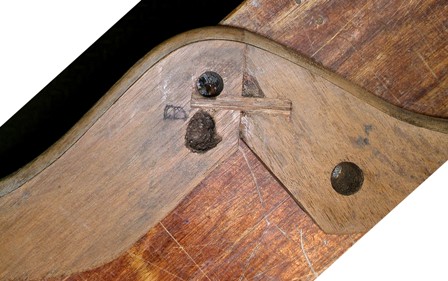
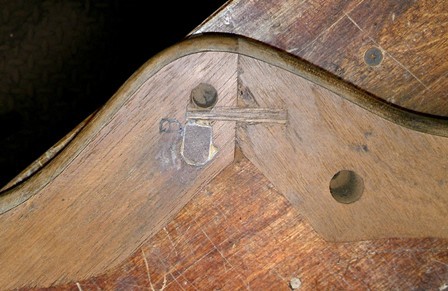
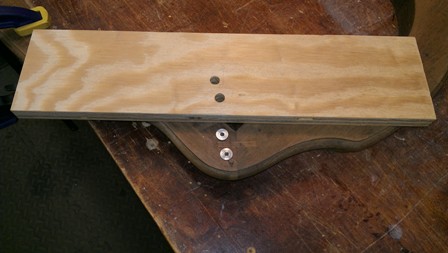
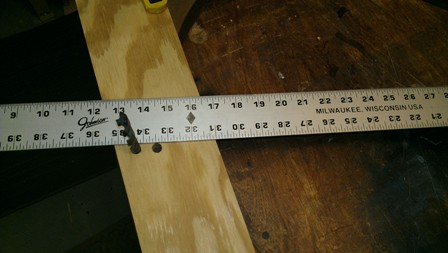
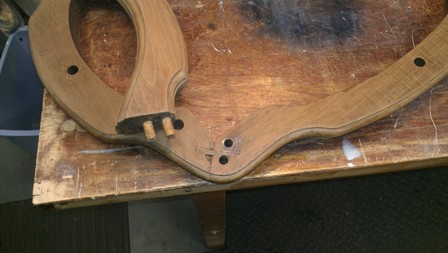
Unequal wear may be explained:
4 legs never hit the floor equally. 3 points define a plane, while the shortest leg is only occasionally needed.
2 dowels “see” different stresses. In a typical (coffee) table rail and leg construction, the dowels are parallel to the floor. The bottom dowel is in the middle of the “beam”, with the top dowel at one end and the leg tip at the other. This creates a long lever which acts on the bottom dowel “first” or more than the top dowel
Since I am not an ME, my common sense analysis may be backwards, but it is clear to me that one of the dowels supports the other dowel.